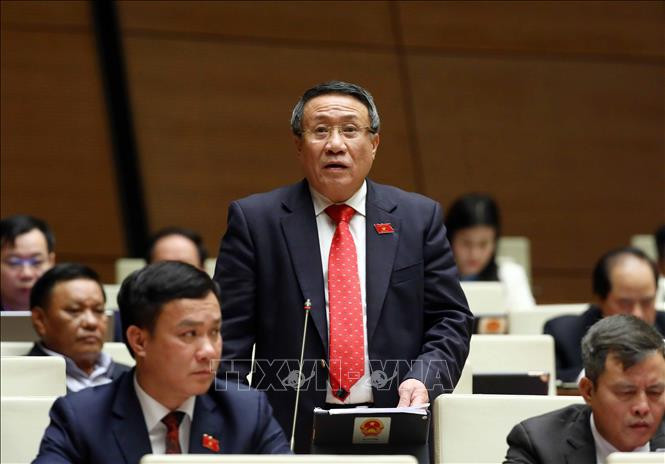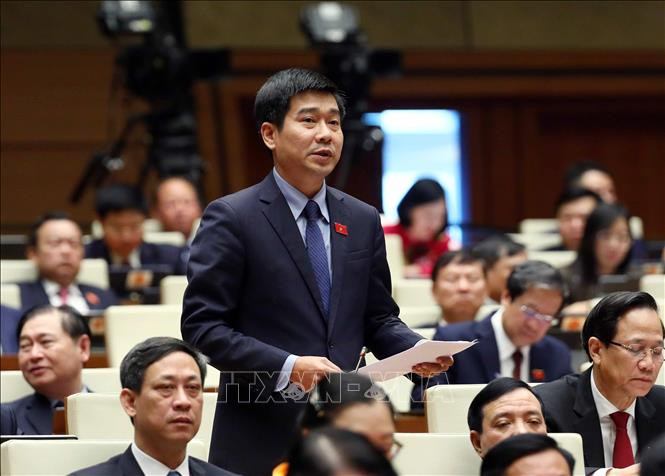Continuing the 5th extraordinary session, on the morning of January 15, the National Assembly discussed in the hall a number of new contents or different opinions of the draft Land Law (amended).

Land valuation method is one of the issues that National Assembly deputies are interested in, focused on discussing and giving opinions.
Need a "lock valve" to control land valuation results
Discussing at the meeting hall, delegate Nguyen Hoang Bao Tran (Binh Duong) stated that point c, clause 5, Article 158 of the draft law stipulates that the surplus method (land valuation method) is implemented by taking the total estimated development revenue, minus the total estimated development cost of the land plot, land area on the basis of the most effective land use (land use coefficient, construction density, maximum number of floors of the building) according to the land use planning, detailed construction planning approved by the competent authority.
Proposing not to prescribe the surplus method in land valuation, delegate Nguyen Hoang Bao Tran explained that the land valuation results when applying the surplus method are carried out on the basis of assumptions and estimates, so the level of reliability is not high for areas with limited actual information and revenue costs to make estimated costs.
In addition, the value of the land plot has the potential to increase over time due to historical processes, commercial activities and other activities on that land plot. However, it is unreasonable to determine the value to always increase gradually because the value of the land plot can decrease when the economy is in recession or facing unfavorable factors. Currently, the real estate market is almost "frozen", this method cannot accurately measure the risk factors, disadvantages for the economy.
"The calculation of the above assumed factors is very complicated, the valuation results are uncertain, inaccurate, and have large errors. For the same plot of land, just changing one indicator in the assumed factors will change the valuation results. This is the cause of confusion and delay in determining and deciding specific land prices in the past and the understanding of each person is different in different circumstances and times," said delegate Nguyen Hoang Bao Tran.
According to delegate Nguyen Hoang Bao Tran, in the context of incomplete price databases and land databases, including data on land prices, markets, and land use rights, which have not been fully and transparently developed, "removing a method of land valuation is also necessary."
"In case it is necessary to retain this method, there needs to be a "lock valve" to control the accuracy and appropriateness of land valuation results," said delegate Nguyen Hoang Bao Tran.
Sharing the same view, delegate Ha Sy Dong (Quang Tri) suggested not applying the surplus method but applying the direct comparison method in land valuation, which would be more accurate.
"The surplus method should only be used for comparison and reference," said delegate Ha Sy Dong.
Regarding the issuance of land price lists, delegate Ha Sy Dong said that "land price lists cannot be created once a year" but should be applied every 5 years. If market prices fluctuate, the coefficient K will be applied to adjust accordingly.
"If the land price list is made once a year, there must be a specialized market research team to build the land price list. Meanwhile, issuing a legal document takes a lot of time, it is proposed to only stipulate once every 5 years," said the delegate, at the same time hoping that the National Assembly will pass the Land Law (amended) this time to pave the way for other laws to come into effect.
More clearly defined land user rights
Regarding the rights of land users, delegate Le Thanh Hoan (Thanh Hoa) said: “The draft law has stipulated general land use rights as well as separate, specific rights in each case. However, the limits of land users' rights have not been really clarified, because according to Article 3, a land plot is a land area limited by a boundary described in the land records or determined in the field. So what is this boundary? Horizontal or vertical? The two-dimensional space needs to continue to be perfected. In reality, most boundaries are only determined horizontally, while vertical boundaries only exist on paper and are mostly not marked in the field. Meanwhile, according to Article 175 of the Civil Code, land users are allowed to use space and underground vertically from the boundary of the land plot in accordance with the provisions of law”.
Citing examples of regulations in some countries around the world, delegate Le Thanh Hoan said that this law amendment is an opportunity to more clearly define the rights, not the obligations, of land users, for the space above and underground, so that when carrying out underground works, outside the scope of the land user's rights, it is not necessary to recover land, at this time only the principle of compensation for non-contractual liability is applied if damage occurs.

Therefore, in order to create a legal basis for the rights of land users as a basis for granting land use right certificates according to land layers, valuing land use fees below the surface, on the basis of the common obligations of land users in Clause 1, Article 31 of the draft law and specifying the surface rights as stipulated in the Civil Code; in sync with Clause 2, Article 116 of the draft law on the right to transfer and lease underground space, delegate Le Thanh Hoan proposed that Article 26 of the draft law supplement the same clause on the rights of land users. Accordingly, land users have the right to use the airspace above the land surface and the land below that surface in a reasonable and legal manner according to the Government's regulations.
Discussing at the meeting hall, delegate Nguyen Dai Thang (Hung Yen) agreed with the regulation that economic organizations and public service units using leased land to collect annual fees are not allowed to sell or mortgage assets attached to the land, but are allowed to contribute capital with assets attached to the land in a detailed manner, creating conditions and reducing financial pressure for public service units.
Regarding the principles of compensation and resettlement when the state reclaims land, delegate Nguyen Dai Thang proposed that regulations must ensure that people have housing, income and living conditions equal to or better than their old place of residence, to be fully and seriously implemented in practice.
Similarly, agreeing with the regulation that resettlement areas must be prioritized in communes, wards and towns where land is recovered, and then expanded to locations in districts, towns and localities with similar conditions, delegate Hoang Van Cuong (Hanoi) proposed adding a regulation to prioritize choosing land planned as residential land, with the most favorable location in the selected area to form resettlement areas.
"This is a lesson learned by Hanoi when implementing the resettlement project of Ring Road 4 - Capital Region, which received great sympathy and support from the people," said delegate Hoang Van Cuong.
THANH BINH (according to VNA)